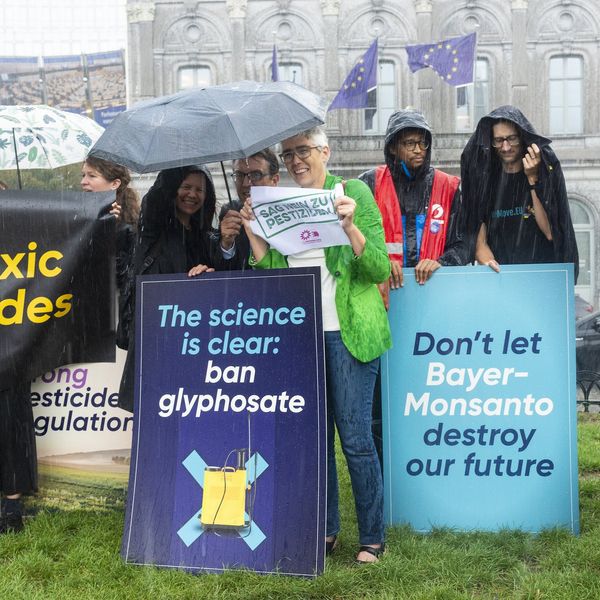Bisphenol A and its substitute chemicals—pervasive in food and beverage containers, canned goods and store receipts—are showing up in mothers' wombs at "unexpectedly high levels," according to a new study published in the journal Environmental Science and Technology.
The study builds on previous evidence that BPA and its common replacement BPS can pass through a mother's placenta and is the first to show the same for a range of other replacements, suggesting that fetuses are being exposed to a cocktail of chemicals linked to behavioral and reproductive disorders, among other health problems.
"We are very clearly seeing these compounds going straight to the baby at totally unacceptable concentrations," Terrence Collins, a green chemist at Carnegie Mellon University, who was not involved in the study, told EHN.
The study, published in March, looked for 15 different bisphenols—including a BPA, BPS and other popular substitutes—in 60 pairs of maternal plasma, cord plasma and placenta samples from pregnant women in South China. Four bisphenols were frequently detected in all three samples: BPA, BPS, BPAF and BPE.
BPSIP, a relatively new compound commonly used in thermal paper for store receipts, appeared at high levels in all maternal plasma samples. The researchers note that BPSIP "exhibits a similar estrogenic potency and greater reproductive toxicity than BPA."
"This is another shriek from nature, 'Stop throwing BPA, or things like it, at me,'" added Collins.
The study is concerning as BPA is a known endocrine disruptor, meaning it is capable of scrambling hormone signals, and has been linked to cancer, diabetes and infertility. In-utero BPA exposure has been shown to derail the normal growth of the brain and other organs and manifest later in life as early puberty or an increase in anxiety-related behaviors or attention deficit hyperactivity disorder (ADHD). Some replacements have been tied to similar issues including obesity and reproductive problems. The new study linked BPAF concentrations in cord plasma with both premature birth and low birth weight.
Most BPA replacements are created by tweaking the BPA molecule to form similar compounds. As a result, most pose similar health concerns. A 2017 study found that six substitutes used in products promoted as BPA-free had as much, if not more, of an estrogen-mimicking effect on human breast cancer cells as BPA.
Pat Hunt, a geneticist at Washington State University in Pullman, Wash., suggested that the latest BPSIP finding reflects an ongoing pattern of regrettable replacements.
"Oh great, another one. When is this going to end?" she told EHN. "We need to worry about all these new players that come onto the scene."
Market expands, leaving children at highest risk
BPA still made up the highest concentrations detected in the new research. Despite thousands of studies that highlight its health effects, the global BPA market continues to increase at about 3 percent per year and is projected to top seven million tons by the end of 2023.
"They are still expanding BPA into every imaginable product," said Collins. "BPA should not be produced. Period."
Meanwhile, the U.S. Food and Drug Administration maintains that the chemical poses no harm at levels to which people are exposed.
In November 2019, EHN published a year-long investigation of the FDA's handling of BPA science. It found that U.S. regulators have stacked the deck against findings from independent scientists that BPA, as well as many BPA substitutes, can harm people at very low doses.
Cheryl Rosenfeld, a biologist at the University of Missouri, published a study of mice in February that found both BPA and BPS exposure lowered serotonin production in the placenta, the primary source of the critical neurotransmitter for developing offspring. The effect could have "dramatic consequences" on brain development, Rosenfeld told EHN.
The bisphenol concentrations that the researchers found in the placenta and cord blood are both troubling, she said, as impacts may come through the placenta or by directly affecting the brain itself. "Yes, it can cross the placenta and that's important because it tells you that whatever mom is exposed to can reach the developing fetus," said Rosenfeld. "But we're even seeing effects before it gets there."
Still, not all bisphenols necessarily behave the same way. For example, BPAF crossed the placenta more readily than other bisphenols highlighted in the new study. "We can't assume that what we know about BPA will translate to the other bisphenols," said Hunt.
Searching for a safe replacement

Valspar cans. (Credit Lynne Peeples)
One newly developed bisphenol might prove a welcome change from its chemical cousins. Valspar, recently acquired by Sherwin-Williams, has created a replacement for food and beverage can linings historically made with BPA.
Rather than just slightly tweaking the chemical structure of BPA, they assessed safety alongside functionality throughout the process. They enlisted academic scientists to test the compound, tetramethyl bisphenol F (TMBPF), for a range of endocrine disruptive activities. "The evidence is very encouraging," said Collins.
"Endocrine disruptors are having a dreadful impact on civilization," he added. "We need to give Valspar its due. But we also need to know more."


























